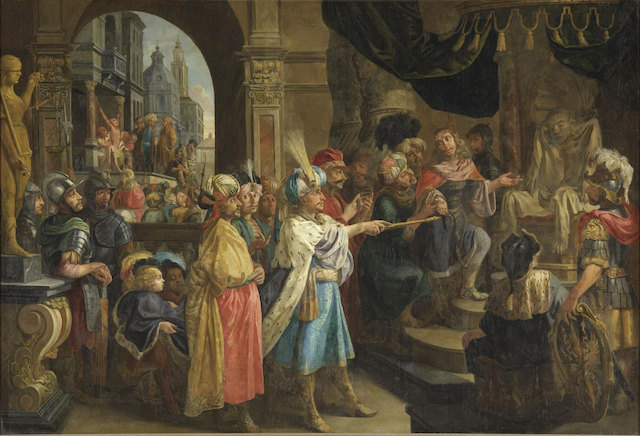It's been a while, but weird historical deaths are back on the menu. Today, we'll look at some of the weird ways people met their end through sex, fire, flowers, baseball, lampreys, and, of course, man's oldest enemy: gravity.
10. Death by Potpourri

We'll start with a story about a deadly joke in ancient Rome, played by one of the most controversial Roman emperors in history, Elagabalus. There are many sordid stories about the young emperor's penchant for hedonism and wealth, so many that it's hard to tell which ones are real and which ones aren't. This particular story comes from Historia Augusta , which doesn't have a terrific track record when it comes to accuracy, but if true, it could represent the only known case of mass murder potpourri .
Elagabalus often enjoyed throwing lavish banquets and playing tricks on his guests. In this case, he used double sided ceiling to rain down tons of flowers on their unsuspecting guests. Some were completely buried under the blooming avalanche and "virtuallysuffocated , unable to crawl to the top."
9. Death by Snoo Snoo

Dying during sex isn't anything particularly noteworthy, but it does raise the stakes a bit when it comes to dad.
John XII is widely considered one of the worst popes in history, remembered today for his many vices, chief among them his love of married women. Just to be fair to John, we should note that, as with Elagabalus, most of the stories about him were written by people who were not members of his fan club. The account of his death, in particular, is told by Liutprand of Cremona, who was a supporter of John’s political rival, the Holy Roman Emperor Otto I.
Now that we've got the disclaimers out of the way, let's get to the good stuff. Pope John XII died on May 14, 964 A.D., as a result of adultery. With unnamed mistress , but the exact cause of death is unknown. Although all versions of events claim that the pope died "enjoying adultery » , some say that John suffered a stroke during the act and lingered for several days before finally going mad. Other versions claim that John XII's demise was more swift and violent, and that he was simply beaten to death by an angry husband who caught him at the crime scene together with his wife.
8. Death by excessive politeness

It’s important to display good manners whenever you’re in public, but not to the point where you literally kill yourself to do so. Take, for example, the strange case of Tycho Brahe, Denmark’s most famous astronomer. Aside from his scientific work, there are two notable facts about him. First, Brahe wore a metal prosthetic nose because he lost his real one in a duel. And second, he died in 1601 after a strange and sudden illness.
In 1901, 300 years after Brahe's death, his body was exhumed and in the hair of his beard were found traces of mercury . This immediately raised the possibility that he had been poisoned, and historians even pointed a collective finger at a suspect: Brahe's assistant, none other than Johannes Kepler, who of course became a famous scientist in his own right. Could it be that Kepler killed his mentor to further his own career?
Not so fast. Later tests using modern technology showed that Brahe had normal level mercury in his system, far below the lethal dose. Instead, it seems that the astronomer's death was caused by a severe bladder infection that led to uremia. During a banquet with the Danish emperor, Brahe drank a lot of alcohol but could not get up to pee because it would have been impolite to leave the table in front of the king. So he just sat there and suffered in silence, and by the time he got home, he had my bladder burst , and Tycho Brahe died 11 days later.
7. Death by skin stool

We go back to ancient times to find the most horrific entry on this list. It's another tale of dubious veracity, this time courtesy of good old Herodotus, who tells us of the horrific way in which the Achaemenid king Cambyses II decided to punish a judge named Sisamen for corruption.
After Cambyses learned that Sisamnes had taken a bribe, the king's throat was cut and skinned . While this was fairly standard for the time, Cambyses then had a leather covering placed over the judge's chair where Sisamnes sat when he passed sentence. He then appointed Sisamnes' son Otanes as the new judge and had him sit on the same chair whenever he passed sentence, as a reminder of what happened to corrupt officials.
6. Death by car

One summer night, 44-year-old Bridget Driscoll from Croydon and her 16-year-old daughter May were walking to Crystal Palace Park in south-east London to attend a party. As they crossed the street, Mrs Driscoll was hit by a car, fatally injuring her. Now we know what you're thinking. It's an unfortunate but all-too-common tragedy. However, Bridget Driscoll's death stands out because it occurred on August 17, 1896, giving her the unfortunate distinction of being the first as a pedestrian, ever killed by a car.
At that time, cars were so rare on the roads that Mrs. Driscoll was simply "confused " this event and did not know how to react. All she could do was hold her umbrella for protection before she was hit.
The driver claimed his car was limited to 4mph, but witnesses insisted the car was travelling at at great speed "like a fire engine" or at the speed of a galloping horse. Bridget Driscoll's death was eventually ruled an accident, and the coroner noted with an abundance of hope that "such a thing will never happen again."
5. Death through ingratitude

On September 10, 490 BC, the Athenian general Miltiades led the Greek forces to victory at the Battle of Marathon, repelling the first Persian invasion of King Darius the Great. Unsurprisingly, Miltiades became the talk of Athens, but his mission was not yet complete. He was then tasked with leading an expedition to Cyclades and to punish some of the Greek city-states that had sided with Persia during the war.
Everyone assumed it would be a walk in the park, especially for the great Miltiades, who had just defeated the mighty Persian Empire. Yet it was not. Not only was the Athenian army defeated, Miltiades injured his leg during the battle.
When Miltiades returned to Athens defeated, no one could believe it. His service against the Persians was immediately forgotten, and one of Miltiades' political opponents, Xanthippus , took the opportunity to accuse the general of treason. Not only that, Miltiades was found guilty and sent to prison. His leg injury was never cured, so it became infected, and the great hero of the Battle of Marathon died of gangrene, imprisoned by the very people he had saved.
4. Death by flying pinto
There is quite a long list of inventors who have been killed by their own creations, and this is unfortunately not surprising. After all, when you try something completely new, it can often be dangerous, even fatal.
Let's take for example, Henry Smolinski and Harold Blake, two aeronautical engineers who founded Advanced Vehicle Engineers, or AVE, in 1971. Their goal was to create a moveable aircraft, or in other words, a flying car.
Unfortunately, the two engineers decided that the car they would use for their invention would be a Ford Pinto, a car with safety ratings that were just one step above riding on the back of a hungry alligator. They strapped the back of a twin-engine Cessna Skymaster , and in 1973 the AVE Mizar was born.
Unfortunately, it was doomed from the start. During the first test flight, the fastening to the right wing strut failed almost immediately after takeoff, but an experienced pilot Charles "Red" Janis prevented it from breaking away completely and knocked Mizar into a field for a rough landing.
Undeterred, Smolinski and Blake built another prototype, and on September 11, 1973, it was time for another test flight. Janisse was away that day, so the engineers took off themselves. The Mizar was in the air for about two minutes before the wings failed and the machine fell 800 feet, bursting into flames on impact and killing both men instantly.
3. Death from too many lampreys
The 12th-century historian Henry of Huntingdon is considered one of England's most important scholars, largely because of his original work Anglophone History , which was a detailed account of English history up to that point. One of the main reasons his book became so popular was that Huntingdon knew how to make his history entertaining. This may have had a negative effect on its credibility, but it did provide us with memorable episodes, such as when King Cnut tried to stop the tides, or when King Henry I died of “an abundance of lampreys » .
Intemperance, by the way, means excess or abundance, which indicates that Henry ate so many lampreys that he became ill and died. We cannot say how many lampreys it took to kill the king, but Huntingdon points out that Henry did so against the direct orders of his court physician.
The king and the chronicler were contemporaries. Henry died in 1135, and Huntingdon published a revised edition of his book that same year. This means that the historian has given us a first-hand account of the king's demise, but it is still a matter of debate whether the "death by lamprey" story holds water or not.
2. Death by wardrobe malfunction

Martha Mansfield was an actress of the silent film era whose career peaked arguably when she played the leading female role in the film adaptation of Dr. Jekyll and Mr. Hyde" 1920 starring John Barrymore. Unfortunately for her, she is best remembered today for her grisly and unusual death.
In 1923, Mansfield again played the leading female role in the drama " The Warrens from Virginia" . The film was set during the Civil War, so it's no surprise that Mansfield had to wear a period costume with crinolines. After the day's shooting, she walked to her car, still wearing her Civil War dress. She climbed into the car and immediately jumped out, engulfed in flames. Her flimsy colonial dress proved highly flammable, and it was only when her co-star Wilfred Lytell jumped on her in his heavy coat that the flames were extinguished. Unfortunately, it was too late, and the 24-year-old actress died of her burns the following day.
Although the culprit was never identified, most people on the set believed that a careless crew member threw a lit match in Mansfield's direction and set her crinoline on fire.
1. Death by Baseball

Finally, we conclude this list by looking at the incredibly strange and unlikely death of a 20-year-old Stanton Walker , who died on October 25, 1902, during a baseball game between two local teams from Morristown and Bethesda, Ohio.
Walker wasn't a player. Instead, he was a spectator, sitting in the stands between two friends named Frank Hyde and Leroy Wilson. At one point, Hyde, who was scoring runs in the game, asked Wilson to borrow his pocket knife so he could sharpen a pencil. Without thinking, Wilson took out his knife and handed it to Walker to pass to Hyde.
Then, in quick succession, several incredible events occurred that led to the tragedy at the baseball game that day. First, Wilson, for some reason, passed the knife blade out. Then, Stanton Walker picked up the knife blade-first, and that's when the ball hit him in the arm and caused him to plunge the knife straight into his chest. Walker began to bleed and died within minutes.













Оставить Комментарий